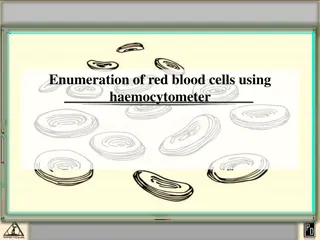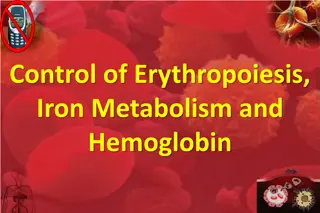Understanding Hemoglobin: Functions, Medical Applications, and Conditions
Hemoglobin, a crucial protein in red blood cells, plays a vital role in carrying oxygen throughout the body. This article delves into its functions, detection methods, medical applications, and common conditions associated with hemoglobin, such as anemia and polycythemia. Learn about the various typ
4 views • 16 slides
Introduction to Haematopathology - Understanding Blood Cell Disorders
Haematopathology is the study of diseases related to blood cells and their production. This branch of pathology delves into haemopoiesis, normal blood constituents, anemia, polycythemia, and more. Learn about erythropoiesis, different blood cell types, erythropoietin, haemoglobin, and disorders like
1 views • 31 slides
Understanding Blood Cell Enumeration Using Haemocytometer
Enumeration of red blood cells using a haemocytometer is crucial to assess blood profiles for conditions like anemia or polycythemia. This process involves manual counting with a specialized apparatus called a Neubauer chamber. The chamber's design includes specific grids and squares for accurate ce
0 views • 15 slides
Understanding Packed Cell Volume (PCV) and Haematocrit (HCT) Testing
Packed Cell Volume (PCV) or Haematocrit (HCT) is a blood test that measures the volume of red blood cells as a percentage of total blood volume. High or low values can indicate specific health conditions like dehydration or anemia. The test is important in diagnosing conditions like polycythemia. Me
0 views • 14 slides
Understanding Red Blood Cell Count Methods
Explore the principles, normal ranges, and conditions related to red blood cell count. Learn about the apparatus and materials needed for RBC counting, as well as the procedure involved. Understand how changes in RBC count can indicate various health conditions like polycythemia and anemia.
0 views • 27 slides
Understanding Packed Cell Volume (PCV) in Blood Analysis
Packed Cell Volume (PCV), also known as hematocrit, is a crucial parameter in blood analysis that indicates the relative proportion of red blood cells to plasma. It is used for detecting anemia, polycythemia, and assessing red cell indices. The Wintrobe method is commonly employed to measure PCV, in
0 views • 9 slides
Understanding Erythropoiesis, Iron Metabolism, and Hemoglobin Regulation
Explore the intricate control of erythropoiesis, iron metabolism, and hemoglobin synthesis in the body. Delve into the role of erythropoietin, factors influencing erythropoiesis rate, essential nutrients like iron and vitamins, and clinical conditions associated with anomalies in these processes. Ga
0 views • 25 slides
Understanding Polycythemia Vera: Causes, Symptoms, and Classification
Polycythemia vera is a chronic myeloproliferative disorder characterized by increased red blood cell production due to JAK2 mutations. Learn about its classification, pathogenesis, morphology, and key differences from secondary polycythemia. Early diagnosis and management are crucial to prevent comp
0 views • 41 slides
Understanding Hematocrit (PCV) Test: Importance and Procedure
Hematocrit (PCV) is crucial for assessing anemia or polycythemia. It measures the percentage of blood volume occupied by red blood cells. This test is accurate and simple, providing valuable information for diagnosing various conditions. Normal values, causes of increased or decreased PCV, and the p
0 views • 23 slides
Understanding the Components and Functions of Blood
Explore the intricate details of blood, the river of life, including its components such as formed elements, plasma, leukocytes, platelets, and the process of hematopoiesis. Learn about the physical traits of blood, the role of proteins in plasma, types of leukocytes, and the importance of platelets
0 views • 16 slides
Clinical Problem Solving Case: The Best is the Enemy of the Good
A 55-year-old man with controlled hypertension and hypothyroidism presents for an executive physical. Despite feeling great, his intense workouts raised concerns. Historical lab review shows a rise in hemoglobin levels prompting investigation into polycythemia, considering primary and secondary caus
0 views • 45 slides










